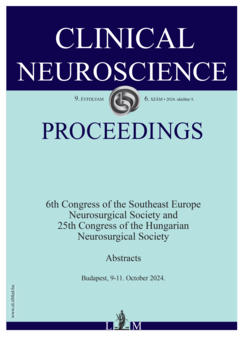Our experiences with endoscopic, endonasal resection of craniopharyngiomas
GUTEMA Emánuel1, REISCH Róbert1, NOVÁK László1
2024. OKTÓBER 09.
Ideggyógyászati Szemle Proceedings - 2024;9(6)
GUTEMA Emánuel1, REISCH Róbert1, NOVÁK László1
2024. OKTÓBER 09.
Ideggyógyászati Szemle Proceedings - 2024;9(6)
Szöveg nagyítása:

Introduction: The ideal surgical trajectory to craniopharyngiomas points through the nasal cavity. The magnification and illumination of the endoscope and nasoseptal flap utilization against CSF leakage made it possible that endoscopic endonasal surgery became the most favourable approach.
Aims: We illustrate our early results with endonasal endoscopic craniopharyngioma surgery to facilitate a constructive discussion about techniques, potential complications and therapeutic strategies.
Methods: We have retrospectively examined our craniopharyngioma cases treated with endonasal endoscopic surgery in the last two years. Tumor extent, surgical videos, resection rates, ophthalmological and endocrinological outcomes, and complications were analyzed.
Results: Nine patients were operated using an uninostril purely endoscopic transethmoidal-paraseptal approach. Five patients had at least one transcranial operation in their history. Postoperative MRI verified macrototal resection in all 9 cases. Until April 2024 two patients had a tumor recurrence. Four of the patients were endocrinologically already fully substituted before the operation. One patient under partial substitution and one without stayed unchanged. Three partially substituted patients needed additional hormonal therapy. Memory impairment was noted in one patient. Visual functions improved in 6 cases, stayed unchanged in 2 cases, and showed worsening in one case due to an occipital hemorrhage. CSF leakage was experienced in two cases and were cured with lumbar drainage and in one case with surgery. Sinonasal outcome test was performed in 8 of the patients preoperatively and 3 months after the surgery. Good nasal function with mild deterioration was recorded in 4 cases, improvement in 3 cases, and unchanged status in 1 case.
Conclusion: Even large tumors can be resected through an uninostril approach with only dorsal resection of the nasal septum, preservation of the turbinates and nasal functions. Neurological and endocrinological impairments caused by surgery must be reduced to achieve a better quality of life. Irradiaton is indicated in selected cases but recurrent tumors may still need repeated surgery.
Funding: no funding involved.
Ideggyógyászati Szemle Proceedings
Despite evidence based institutional protocols being in place in many countries, aneurysmal subarachnoid hemorrhage (SAH) continues to be a major socio-economic burden with many open questions remaining regarding the optimal management of the affected patients.
Ideggyógyászati Szemle Proceedings
Arteriovenous malformation (AVM) is an anomaly of blood vessel formation. Numerous models have been established to understand the nature of AVM.
Ideggyógyászati Szemle Proceedings
Additive manufacturing has gained significant traction in industrial applications due to its high potential when it comes to manufacturing objects with complex geometry.
Ideggyógyászati Szemle Proceedings
Not only other surgical and robotic fields, but minimally invasive procedures in spine surgery have undergone significant development in recent times. A demand emerged from both surgeons and patients to develop and perform these types of surgeries in order to prevent biomechanical and surgical complications.
Ideggyógyászati Szemle Proceedings
Functional magnetic resonance imaging (fMRI) is crucial for presurgical language mapping in neurosurgery, helping identify eloquent brain regions to preserve during operations. Effective language mapping depends on advanced fMRI acquisition and detailed data analysis to ensure accurate clinical outcomes.
Ideggyógyászati Szemle Proceedings
Despite evidence based institutional protocols being in place in many countries, aneurysmal subarachnoid hemorrhage (SAH) continues to be a major socio-economic burden with many open questions remaining regarding the optimal management of the affected patients.
Ideggyógyászati Szemle Proceedings
Arteriovenous malformation (AVM) is an anomaly of blood vessel formation. Numerous models have been established to understand the nature of AVM.
Ideggyógyászati Szemle Proceedings
Additive manufacturing has gained significant traction in industrial applications due to its high potential when it comes to manufacturing objects with complex geometry.
Ideggyógyászati Szemle Proceedings
Not only other surgical and robotic fields, but minimally invasive procedures in spine surgery have undergone significant development in recent times. A demand emerged from both surgeons and patients to develop and perform these types of surgeries in order to prevent biomechanical and surgical complications.
Ideggyógyászati Szemle Proceedings
Functional magnetic resonance imaging (fMRI) is crucial for presurgical language mapping in neurosurgery, helping identify eloquent brain regions to preserve during operations. Effective language mapping depends on advanced fMRI acquisition and detailed data analysis to ensure accurate clinical outcomes.
The indication of combined endoscopic transnasal and transcranial/transorbital surgery of skull base tumors
The indication of combined endoscopic transnasal and transcranial/transorbital surgery of skull base tumors
1.
2.
3.
4.
5.
Egészségpolitika
Hadiállapotként kezeli és így is reagál a kormány az egészségügy „rendezésére”1.
2.
3.
4.
5.